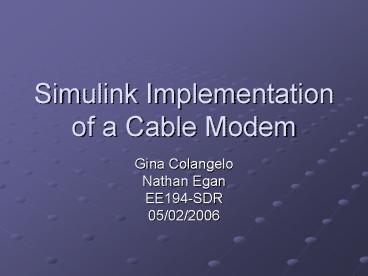Simulink Implementation of a Cable Modem PowerPoint PPT Presentation
1 / 19
Title: Simulink Implementation of a Cable Modem
1
Simulink Implementation of a Cable Modem
- Gina Colangelo
- Nathan Egan
- EE194-SDR
- 05/02/2006
2
Topics Covered
- Cable Data Network Overview
- Cable Modem Architecture
- Downstream/Upstream Specifications
- Simulink Implementation
- Implementation Results
3
Cable Modem Network Overview
- Headend DOCSIS-certified CMTS (Cable Modem
Termination System) - One Headend supports 2000 Cable Modem Users on
a single TV Channel - CMTS interfaces the CATV network to the Internet
- CMTS output channel combined with TV video
signals - CATV Network to Subscriber via coaxial cable
- One-to-Two splitter One signal to Set Top Box
(STB), other to Cable Modem - Cable Modem
- One Modem can support up to 16 users in a
local-area network - PC/Ethernet Card
- Cable Modem connected to PC via Ethernet, USB,
PCI Bus, etc
4
Cable Modem Architecture
- Transmit/Upstream
- QPSK/QAM Modulator performs
- QPSK/QAM-16 modulation
- Reed-Solomon Encoding
- D/A Conversion
- Up-conversion to the selected frequency/channel
- Receive/Downstream
- RF Tuner
- Converts TV Channel to a fixed lower frequency
(6-40MHz) - QAM Demodulator performs
- A/D conversion
- QAM-64/256 demodulation
- MPEG frame synchronization
- Error Correction (Reed-Solomon)
- MAC - Media Access Control
- Implemented partially in hardware and software
- Data and Control Logic
5
Receive Path
- Diplex Filter splits/combines bands for 2-way
capability on CATV systems - Tuner isolates TV channel and mixes it down to
Analog IF (6-40MHz) - Analog to Digital Conversion
- Decimation Filters to down-sample to the symbol
rate (e.g. CIC) - QAM Demodulator
- MPEG Frame synchronization
- Automatic Gain Control (AGC)
- Equalizer removes distortions, and cancels
echoes or multi-path conditions - Carrier Removal
- Automatic Frequency Control (AFC)
QAM Demodulator
Generic Receive Path of a Cable Modem
6
Downstream Specifications
- Frequency Range 65-850MHz
- Bandwidth 6MHz (USA) or 8MHz (EU)
- Modulation 64-QAM (6 bits/symbol) or 256-QAM (8
bits/symbol) - Data rate 27-56 Mbps (depends on modulation and
bandwidth) - Continuous stream of data
- Framing MPEG-2 (based on DOCSIS spec)
- Encryption DES (Data Encryption Standard)
- Reed-Solomon Forward Error Correction
- Symbol rate listed under Modulation does not
compensate for error correction and other
overhead - Data rates listed in the table use a symbol
rate of 6.9 Msym/s for 8MHz BW and 5.2Msym/s for
6MHz BW
7
Transmit Path
- QAM (Burst) Modulator
- Reed-Solomon Encoder (Forward Error Correction)
- Randomizer/Scrambler whitens the data
- Helps to avoid discrete spurs in output spectrum
- Improves synchronization at the receiver since
data is more equiprobable - Preamble Insertion
- Inserts a training sequence into the system
- Transmitted without R-S Encoding or Scrambling
- Modulation Encoder (QPSK/16-QAM)
- Pulse Shaping (e.g. Raised Root Cosine)
- Programmable Interpolation Filters (e.g. CIC)
- Programmable NCO, digitally modulates carrier
anywhere in the Nyquist Bandwidth - Digital to Analog Conversion
- Variable Gain CATV Line Driver
QAM Modulator
To Diplexer
Preamble Insertion
Programmable Interpolation Filter
Digital Data In
Program- mable NCO
Pulse-Shaping FIR Filter
Reed- Solomon Encoder
Modulation Encoder (QPSK/16-QAM))
Randomizer
MUX
DAC
Pulse-Shaping FIR Filter
Programmable Interpolation Filter
Variable Gain CATV Line Driver
Fixed Freq
Digital Control Logic/Signals
8
Upstream Specifications
- Frequency Range 5-65 MHz
- Variable Bandwidth 200 kHz to 3.2 MHz (2 MHz
typically) - Modulation QPSK (2 bits/symbol) or 16-QAM (4
bits/symbol) - Data rate Variable 320 Kbps to 10 Mbps
- Transmit bursts of data in timeslots (TDM)
- Encryption DES
- Reed Solomon Forward Error Correction
9
TX Implementation
- 16-QAM Modulation 320ksps
- Raised Root Cosine Filter
- Upsamples by 8, data rate at output 2.56Msps
- Roll-off factor 0.7
- FIR Interpolation Filter
- Polyphase Implementation
- Interpolates by 32, data rate at output
81.92Msps - Order FIR filter 60, Cutoff Frequency 320kHz
- NCO - Mixes signal up to 30MHz
- Gain factor of 30 to compensate for losses
throughout path
10
TX Spectrum
Power
Output from the RRC Filter
MHz
-1.28
1.28
0
Power
Sampled signal after interpolation
FIR Interpolation Filter Response
MHz
0
-40.96
40.96
Output signal from up-conversion
Power
MHz
40.96
-40.96
30
-30
0
Interpolation Images will occur every 2.56MHz
11
RX Implementation
I Rx FIR 32x
I
Raised Root Cosine Rx Filter
RF Input
QAM Demodulator
Baseband Signal
Q Rx FIR 32x
Q
COS
SIN
NCO
- NCO - Mixes signal down to Baseband
- FIR Decimation Filter
- Polyphase Implementation
- Decimates by 32, data rate at output 2.56Msps
- Order FIR filter 10, Cutoff Frequency 1.28MHz
- Raised Root Cosine Filter
- Downsamples by 8, data rate at output 320ksps
- Roll-off factor 1
- 16-QAM Demodulation
12
RX Spectrum
Power
Input signal to demodulator
MHz
40.96
-40.96
30
-30
0
Power
Signal after the down-conversion
Input Signal
-60
MHz
60
0
Power
Sampled signal after decimation
FIR Decimation Filter Response
MHz
0
-1.28
1.28
Power
Input to the QAM demodulator
RRC Filter Response
MHz
0.32
0
-0.32
13
Simulink Block Diagram
14
Simulink Results TX Path
TX Signal After Pulse Shaping
TX Signal After 32X Interpolation
TX Signal after Up-Conversion
15
Simulink Results RX Path
Rx Signal After Down-Conversion
Rx Signal After 32X Decimation
16
System Results Time Domain
Delay Through Data Path
17
System Results 2
RX Constellation
TX Constellation
18
Simulink Results - BER
- BER with current implementation 0.9741
- What effected BER?
- Design of the FIR
- SNR of datapath (AWGN Channel)
- Design of Raised Root Cosine Filter
- Main Tradeoff
- Dynamic Range/Spurious Content vs EVM/BER
- Better Implementation
- Compensation Filter after Interpolator and
Decimator
19
Websites for More Info
- http//www.ciscopress.com/articles/article.asp?p3
1289seqNum2rl1 - http//www.iec.org/online/tutorials/acrobat/cable_
mod.pdf - http//www.cable-modems.org/tutorial/index.htmTOC
- http//www.broadcom.com/collateral/pb/3349-PB01-R.
pdf - http//www.analog.com/UploadedFiles/Data_Sheets/13
374136AD9853_c.pdf - http//www.wideband.com/products/Modems/QAM20Mod/Q
AMmod.html - http//focus.ti.com/lit/an/slwa023/slwa023.pdf
- http//www.broadcom.com/collateral/pb/3419-PB02-R.
pdf - http//www.cableaml.com/website3/wireless_catv/des
criptions.htm - http//www.fcc.gov/mb/engineering/cablemqa.html
- http//www.cablemodem.com/
- http//www.nextgendc.com/index.htm
- http//computer.howstuffworks.com/cable-modem.htm
- http//compnetworking.about.com/od/dslvscablemodem
/a/dslcablecompare.htm

